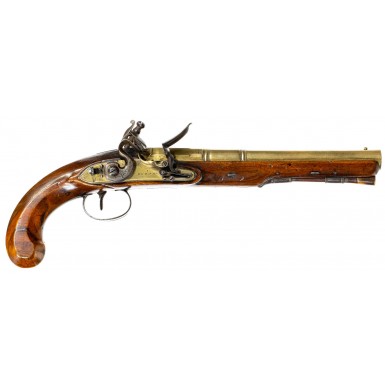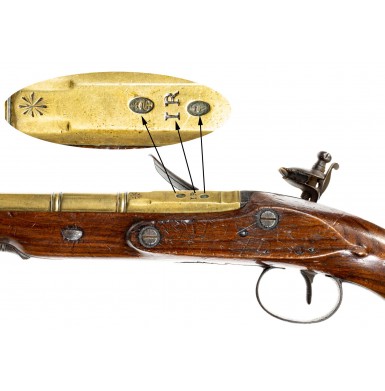Attractive Brass Barreled Flintlock Holster Pistol by John Richards of London
- Product Code: FHG-2230-SOLD
- Availability: Out Of Stock
-
$1.00
This is a really lovely original and unaltered Brass Barreled Flintlock Holster Pistol by John Richards of London. The pistol is from the latter part of the 18th or early part of the 19th century and was likely produced circa 1790-1810. According to Blackmore’s Dictionary of London Gunmakers 1350-1850, John Richards may have been from Birmingham originally. In 1775 he was established at 114 Strand at the corner of the Savoy Steps. In 1778, he moved to 25 Strand, where he remained through 1780. He was located at 4 Ball Alley, Lombard Street from 1781-1783 and moved back to the Strand at number 54, near the Adelphi in 1782. He remained there through 1808. He moved next door to #55 Strand in 1809 where he remained in business until his death in 1821. Blackmore further notes that Richards was “free of Gunmakers Company, by redemption, 1781”, meaning that he was a master gun maker at that point. As was common during the period, Richards used the archaic “I” to represent the letter “J” on his work, which is why his guns are marked “I RICHARDS”. Blackmore illustrates Richard’s IR touch mark as figure 187 on page 214 of his book, allowing definitive identification of this pistol as being the work of John Richards (1).
The pistol measures 14 ½” in overall length with a 9 1/8” brass barrel that is secured with two flat keys and a screw through the iron breech tang. The barrel is a classic mdi-18th century style, three-stage design with an octagonal breech and two round sections, with the baluster turned rings at the transitions and a slightly swamped muzzle. The smooth bore pistol is nominally .58 caliber, or 24-Bore, which the British military would refer to as “pistol bore” during the period. The top flat of the barrel is engraved STRAND – LONDON, indicating the pistol was produced while Richards was at one of his Strand addresses. The left angle flat of the breech has two raised London commercial proofs in depresses ovals, the usual {CROWN}/V and {CROWN}/GP. Richards’ IR maker’s mark is present between the two proofs. Three lightly engraved decorative starburst patterns are present on the top and two upper angled flats of the barrel, right before the transition to the first round section. The breech tang section is engraved with light foliate themes and geometric boarder patterns, with the tang screw lightly engraved as well. The two lock mounting screws are similarly engraved, matching the tang screw. The lock plate is also brass, matching the barrel. It is a flat, stepped lock with a small teat at the rear and a beveled edge that measures 4 ½” in length. The bolted lock has a sliding safety at rear that can be made to engage the cock as it is brought to half-cock, locking it in place. The lock has a rounded and fenced integral bridled brass pan with a roller frizzen. The cock is of the flat beveled, swan-neck design with simple foliate engraving on the neck. The lock is engraved I / RICHARDS in two-lines under the pan and has as simple decorative quarter starburst motif engraved at the upper edge of the lock between the pan and cock. The pistol is mounted with blued iron furniture with engraved foliate themes on the triggerguard bow, which terminates in an engraved pineapple finial. The pistol has a lightly engraved iron entry pipe and a single round thimble with baluster turned rings that secure a horn tipped wooden ramrod. The stock is gracefully carved of moderately figured walnut with pronounced flats on either side of the grip and a flat area that extends from the rear of the triggerguard around the rear of the grip, including the backstrap. The flat pattern of the grip is a style found on holster and officer’s pistols by Henry Nock that were produced during the same era as this pistol, around 1800. Both the lock mortise and counterpane terminate with a simple flat finial apron at their rears.
The pistol remains in FINE condition and is extremely attractive. It remains 100% complete, correct and original, with both the lock and barrel in their original flintlock configuration. The engraved and stamped markings remain clear and crisp throughout and are all clearly legible. Both the lock and barrel have a mellow golden patina that shows no indication of having been cleaned in recent times. The iron furniture and cock have a dull, smoky gray patina with the triggerguard showing some minute traces of blue in protected areas. The metal remains crisp and sharp with clear engraving and shows no pitting, only some light surface oxidation and discoloration. The lock remains mechanically fine and fully functional, including the cock locking safety at its rear. The bore of the pistol is in VERY GOOD condition with some moderate oxidation and some scattered discoloration along its length but no real pitting to speak of. The stock of the pistol is in about FINE condition as well. It is full-length, and free of any breaks, cracks or repairs. The stock shows no signs of sanding and retains crisp edges and sharp lines. The wood does show scattered bumps, dings and mars with a handful of small impact marks on the butt of the grip. The horn-tipped wood ramrod matches the gun perfectly and appears to be original to it. The rod shows moderate wear and some minor loss to the horn tip, where some of the thin horn is now missing, revealing the wood shaft underneath.
Overall this is a really attractive Brass Barreled Flintlock Holster Pistol by John Richards of London produced circa 1790-1810. The gun was either produced for purchase by a junior officer in the British Army or for protection by an upper class gentleman. It was almost certainly part of a pair when originally sold. The pistol has wonderful lines and remains quite crisp with clear markings and fine mechanics. While likely from the post-Revolutionary War period, the pistol was produced by a quality London gun maker who worked during the Revolution, as well as during the Napoleonic War period. This would be a lovely addition to any collection of late 18th or early 19th century English arms and would be quite appropriate to a collection of Napoleonic or War of 1812 period English arms as the gun was quite likely owned by an officer who saw service during those conflicts.
SOLD
Tags: Attractive, Brass, Barreled, Flintlock, Holster, Pistol, by, John, Richards, of, London











